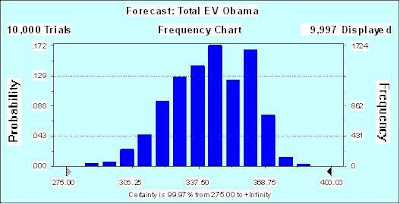Presidential Election 2008 - McCain v/s Obama - Final
Without further ado, here are my final predictions from a statistical simulation model to predict the outcome of the 2008 presidential election. As before, the model accounts for the fact that the reported voter preferences are only one of many likely scenarios because of the statistical margin of error inherent in all polls. Using Monte Carlo simulation, I can generate many such scenarios, and tally the results to predict the range of likely outcomes and the probability of various outcomes.
For this simulation, I used the latest Real Clear Politics poll averages of 15 battleground states - AZ, CO, FL, GA, IN, MO, MT, NV, NM, NC, OH, PA, SD, VA, and WV. See my previous post from October 30th for details about the model and its assumptions after the results.
RESULTS (from 10,000 simulations):
- Average number (mean) of Obama electoral votes => 333
- Standard deviation => 21.3
- Range corresponding to 68% probability => 354 - 312 EV
- Probability of Obama win => 99.85%
- Best case / worst case scenario => 393 - 257 EV
- States with the greatest impact on likely outcomes => FL (51%), OH (21%), NC (11%), VA (5%), MO (5%)

Until tomorrow evening, when truth awaits .....







